[SSI, Apple II]
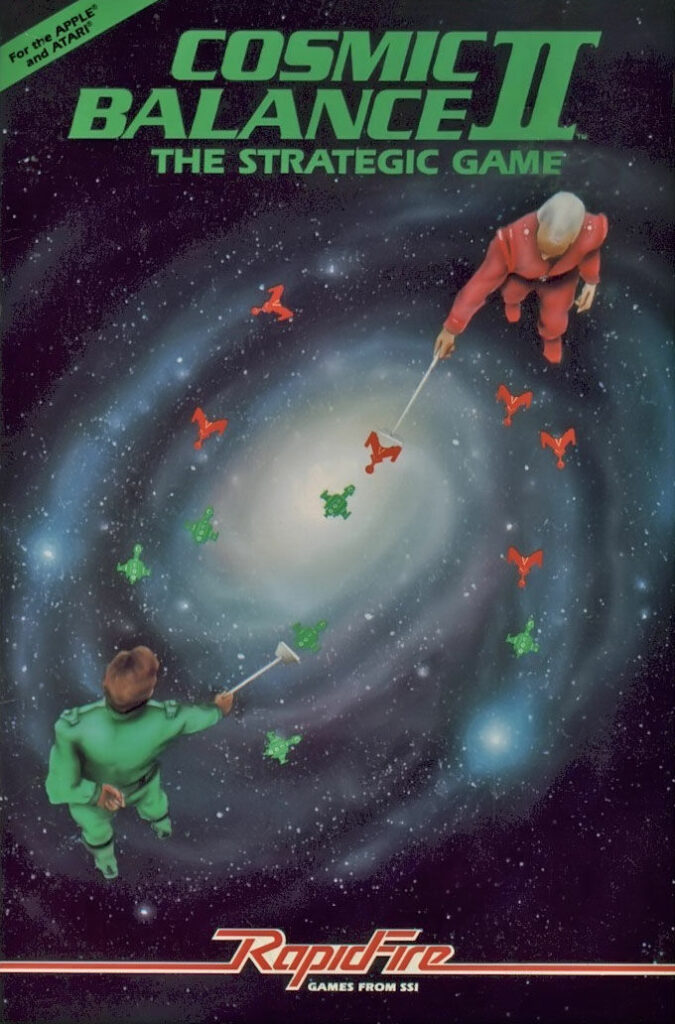
Alcyon IV. The luxurious Alcyon IV. The most fertile planet of the universe. They say anything you put into the ground grows into a tree within weeks. Alas, we will never colonize it !
But why ? Is it kept as a natural reserve ? Vicious aliens ? Deadly virus ? Poisonous air ?
Not at all ! We already have 7 farming worlds in Alcyon IV’s sector, and the beancounters say we don’t need an 8th one !

Immediately upon releasing its tactical space game The Cosmic Balance in Summer 1982, SSI had announced a “strategic adjunct” : “we hope the combination of these two games will make for the ultimate space-war simulation.” Initially announced for winter 1982-1983 latest, fans had to wait a bit longer than expected as the adjunct – Cosmic Balance II (dropping the “The”) – was only released in May 1983.
Even though it was released as part of the RapidFire series, Cosmic Balance II is a complex and unintuitive game, so much so that for one of the first time in wargame history, it includes as a sort of tutorial several scenarios of increasing complexity, following humankind’s development from the dawn of space colonisation to an existential war against a rival interstellar empire. Doing several short AARs following those scenarios is my best way to introduce the game.
Was Cosmic Balance II worth the wait ? Eh ! You decide.
1. Terran Expansion (4 HE – 60 HE)
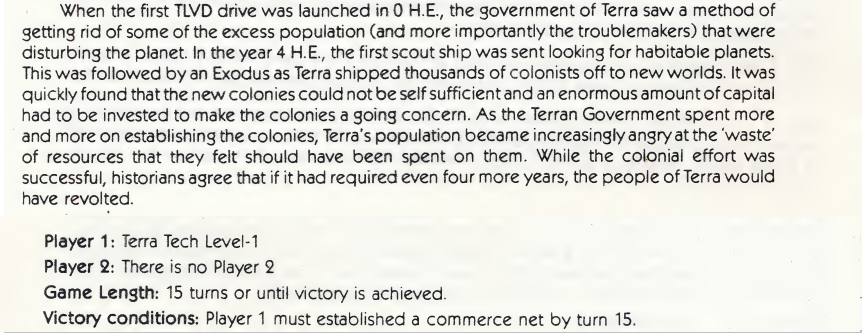
The first scenario is without opposition, but introduces the most important – and the weirdest – feature of Cosmic Balance II : the commerce net.
A commerce net is a group of planets (exactly 7 farming planets, 2 mining planets and 1 industrial planet) that are connected by a trade route (one or several commerce missions in game terms) moving a total of 18 resource points. A commerce net is one of the two ways to generate industrial output (IO) points, which is the game’s main resource, the other way is to simply own a “Terran Planet”, which generates 1750 IOs every turn by just existing.
It turns out that I start the game with no farming world, no mining world and no industrial world, the only thing I have is one of those Terran planets : Earth ! This is really the dawn of space travel.

I don’t know anything about my starting sector, so I need scouts – ships with a range greater than 0. I don’t expect to meet any alien life because, look, it says “there is no player 2” right here in the scenario description, so I don’t need warships. Traders and other sorts of merchant ships will do :
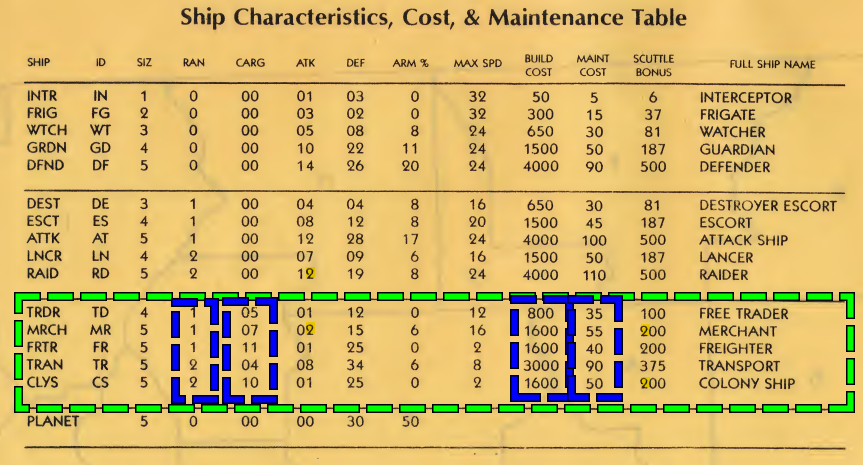
I buy 2 free traders for 1600 IOs. The rest (150 IOs) is automatically converted into supplies – this conversion is important because supplies can’t buy ships, so you will never be able to buy one of those fancy ships costing 4000 IOs if you generate only 1750 IOs every turn.
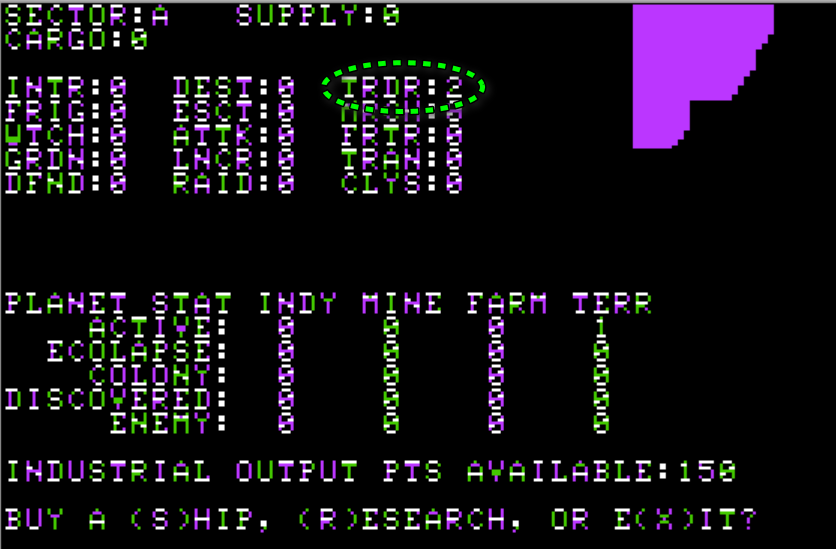
I send my free trader ships on a scouting mission, and they find a mining planet and a farming planet. Yay !
That’s the end of the first turn.
The following turn – 4 years later – I buy one additional free trader which I use for a supply mission.

A supply mission lifts some of the supplies stockpiled in a sector and makes them available for colonisation. My first colony will be an industrial planet, costing 700 supplies by turn.
The reason I start with an industrialized planet comes from another (questionable) feature of this game : as long as your planets are not in a commerce net, you need to pay their maintenance cost every turn, whether they are fully colonized or not. Which means it is better to start with the kind of planets that are the longest to colonize.
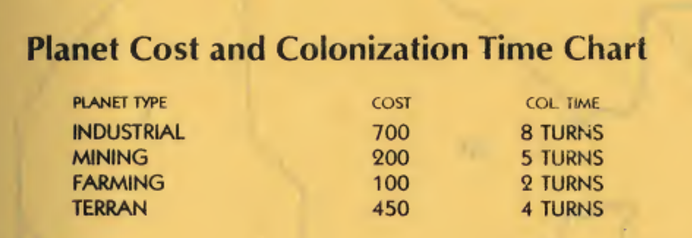
That’s pretty much all there is to say. I spent the rest of the campaign stockpiling supplies, scouting, and colonizing the necessary planets. I started colonizing the mining planets when there were 5 turns left for the industrial colony, and then the farming planets when there were 2 turns left. The only luxury I allowed myself was the acquisition of a freighter ship
This took a lot more keystrokes than should have been necessary – there is no “supply all” command for instance.
Fiinnaaalllyyyy turn 12 I am almost there :
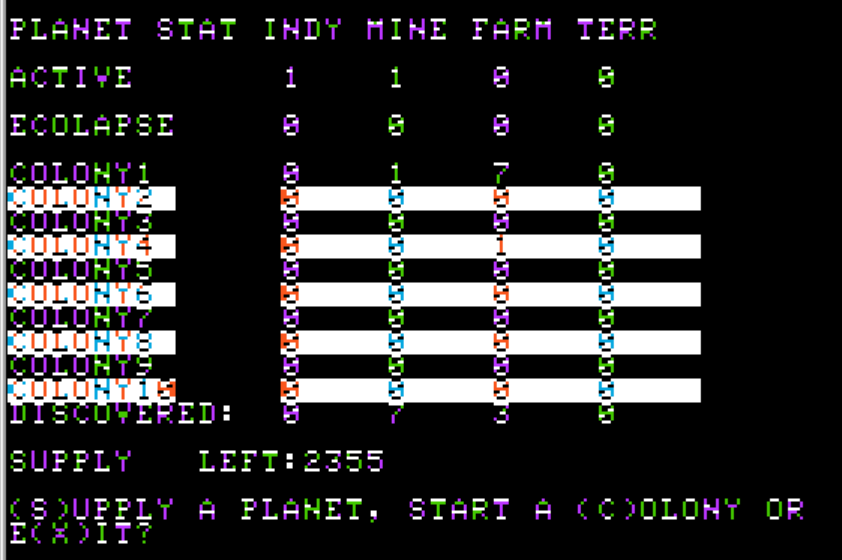
- My freighter ship runs its usual supply mission (it can carry 11 in cargo, which translates into 11×250 = 2750 supplies when I need 1 800 to supply all colonies);
- My now 4 trader ships run a final commerce mission. As I explained earlier, a commerce net requires the ship running the commerce mission to bring 18 resource points (“cargo” as I will say from now on), and each of my trader ships brings 5. Once the minimum requirement of 18 cargo is met (which in itself does not generate revenue), any extra cargo in the commerce mission(s) generates 250 IOs, up to a maximum of 2500 IOs. Not that I care – I just won the scenario.
Or did I ? I didn’t see any “You won” message ! Am I forgetting something ? I check the manual again :

Disappointing.
This took me a good 45 Zzzzzzzzz-ish minutes to play, and the only real challenge of this first scenario is to avoid mistyping while watching TV or listening to a podcast or whatever – but well that was a tutorial and at least at his point the notion of “commerce net” should be clear for everyone. Things are about to heat up!
2. Colonial Wars (112 HE – 120 HE)
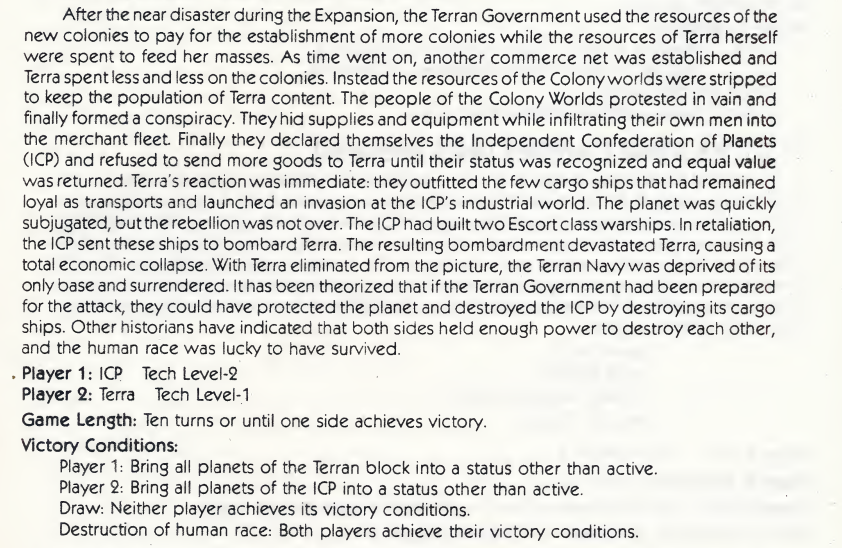
Well, Space has just gone Defcon 2.
This campaign still only uses one sector, but it is vividly contested :
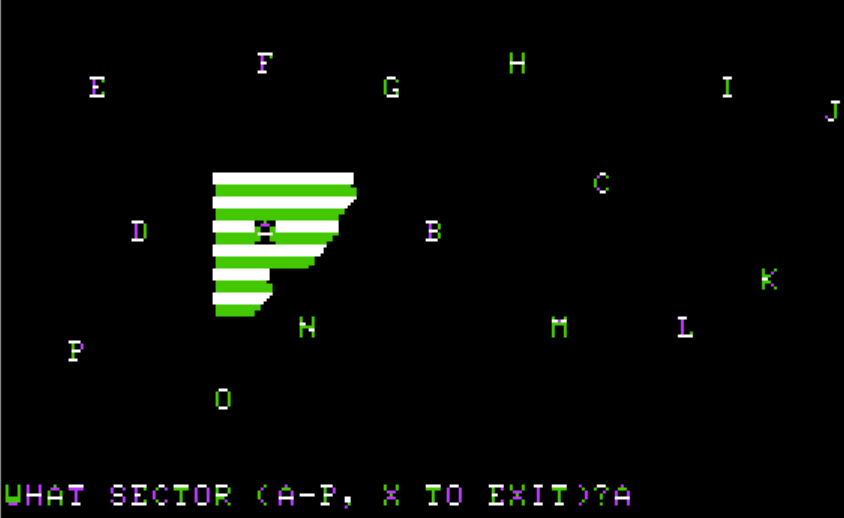
In sector A, the rebel scums control a few scattered planets and Earth… wait ! this means I am the rebels and they are the imperial scum ! My apologies.
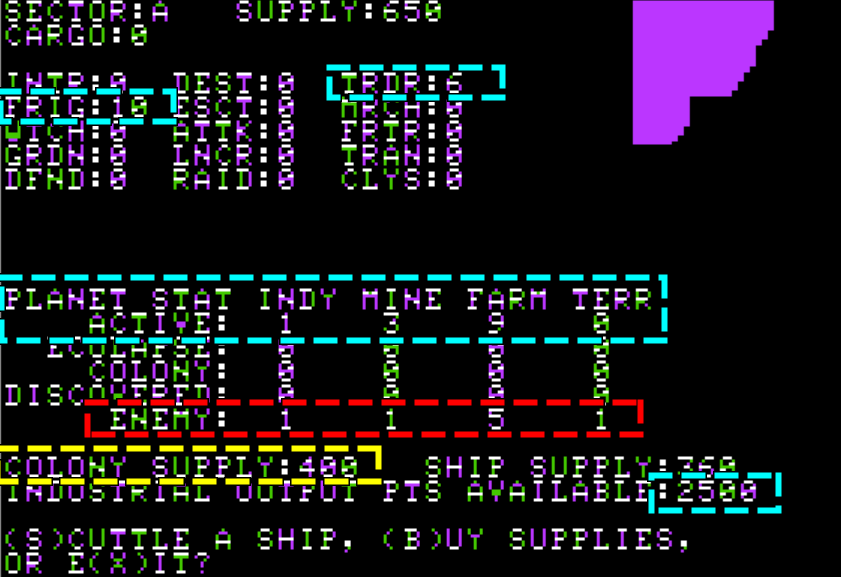
I start with a commerce net which can yield up to 2500 by turn, whereas the Terrans’ only revenue is from Earth, generating 1750 by turn. If I take Earth, it is game over for them. If they take my industrial world, it is game over for me – for the rest I have some redundancy.
I also start with 6 free trader ships (enough to carry 30 cargo, which maintains the commerce net and generates 2500 IOs) and 10 Frigates, weak planetary defence ships whose only available mission, for now, is garrison (protecting planets from attacks).
The first turns are calm – the Terrans are not attacking. I scuttle half the frigates because they eat up my supplies, and replace them with better planetary defence ships called “watchers”. I also buy a few free traders and freighter ships for redundancy and, well, future planetary invasion.
Soon, I also buy :
- An “escort”, a medium-range ship which can do everything the planetary defence ships cannot, in particular scout, patrol, escort and attack,
- A “lancer”. While weaker than the escort, the lancer is a long-range ship, which means it can raid neighbouring sectors (useless in this scenario) but also that it can carry one planetary ship with it in its missions.
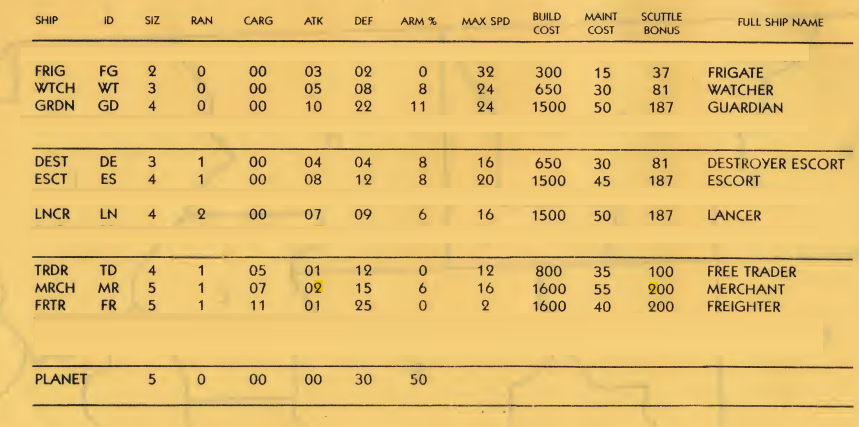
I still run missions every turn of course. My missions for turn 3 look like this :
- The freighter and 4 free traders run a commerce mission. Together they carry 31 cargos so they generate the maximum of 2500 IOs every turn. I don’t allocate any escort and pray that the AI does not run any commerce raid mission,
- A free trader runs a supply mission – if a planet is bombarded ma non troppo, then supplying it can immediately bring it back to the commerce net without losing a turn and the associated revenue,
- The escort, the lancer and a (carried) watcher on patrol ; ships on patrol have a chance to intercept any hostile mission in their sector.
- The rest of the planetary ships are automatically given a “garrison” role and are randomly allocated to individual planets,
Turn 4, I finally buy a guardian (a powerful planetary defence ship), and I launch my first invasion mission to recover Earth !
Just as my most powerful warships are away, I receive an unfortunate piece of news.

I lose a planet, a frigate and significant chunk of my corn production.
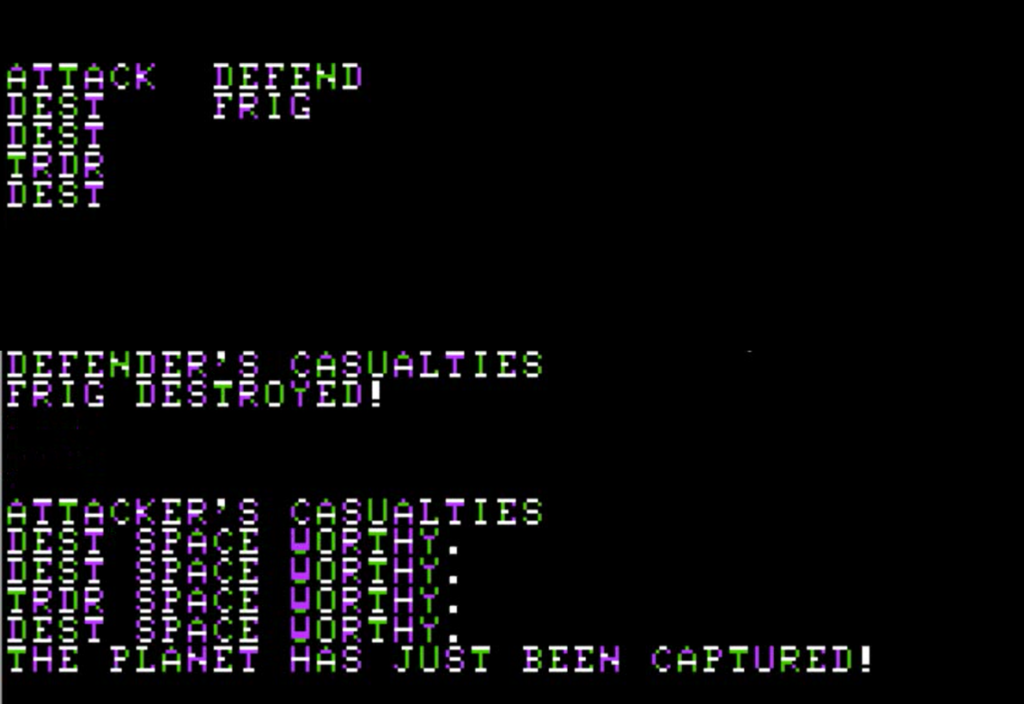
I am not too worried yet, I still have enough farming planets for my net and I am going to conquer Earth anytime now !

Damn ! Patrol ! Whether I win or I lose the battle, the invasion itself will be cancelled.
At least, the battle goes well, even though I lose my trade/troop transport ship :
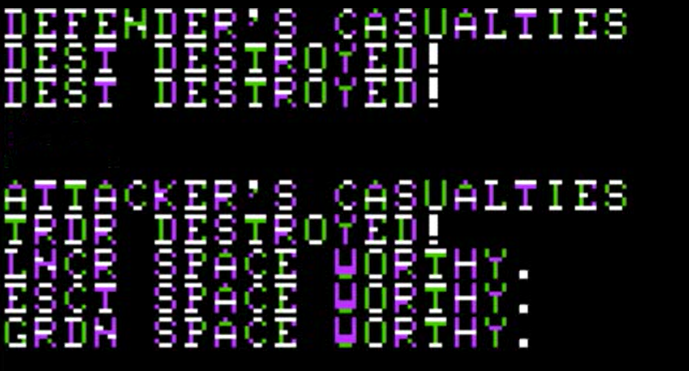
Clearly, Free Traders are not the best ships for invasion – too fragile. Learning from my mistake, I buy a sturdier merchant ship the following turn, and try another invasion !
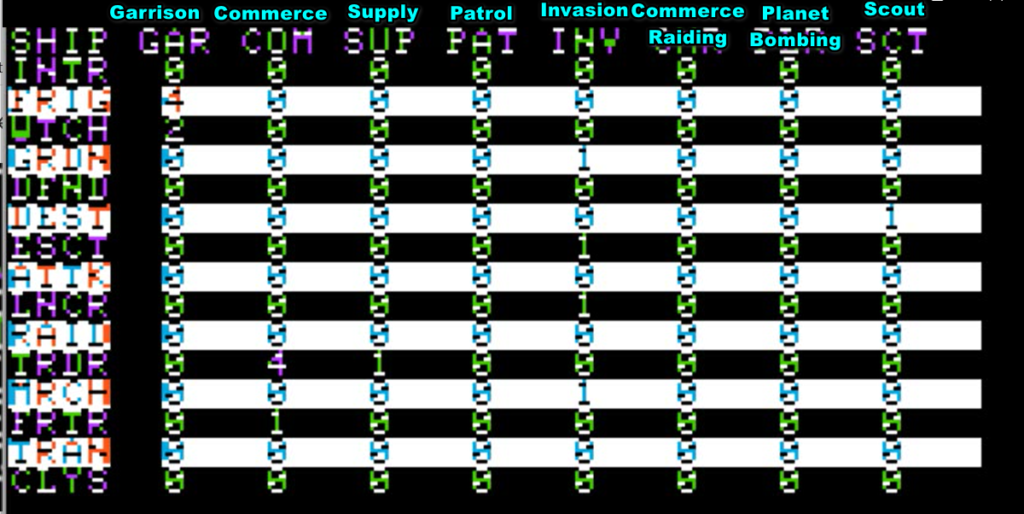
This time, I manage to evade patrol. Some planetary defence intercepts my fleet, but my merchant makes it through, and I capture Earth ! Who’s the imperial overlord now ?
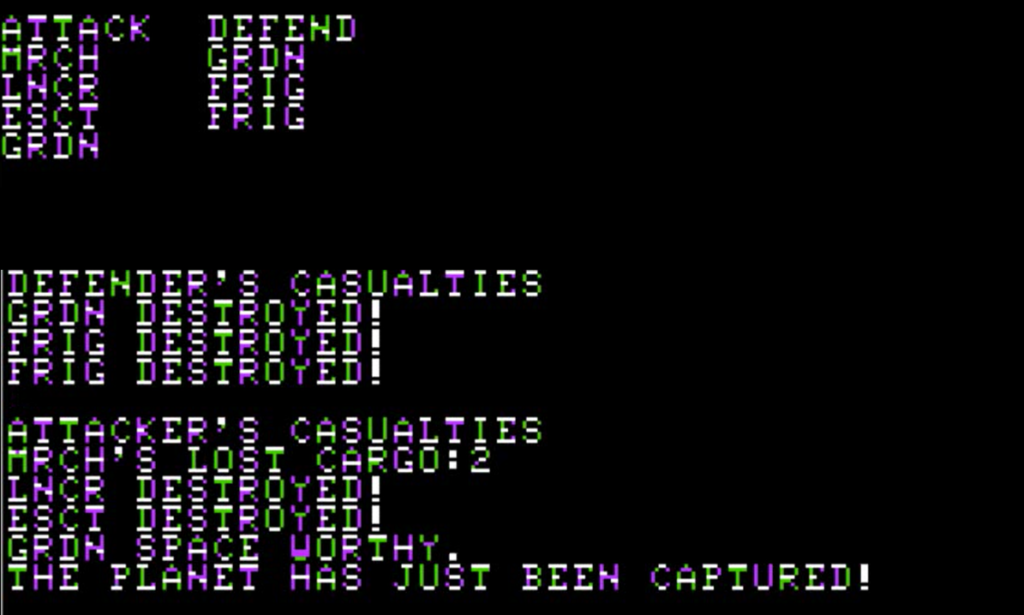
Meanwhile, the Earthlings invade one of my defenceless mining worlds, but that’s not enough for them to complete their deck – they are lacking one farming world.
Certainly they will do everything they can to take it. I brace for impact…

Ah… fine ! Easier this way.
3. First Contact (208 HE – 248 HE)

Finally ! Aliens !
For the first time, something is happening in a neighbouring sector :
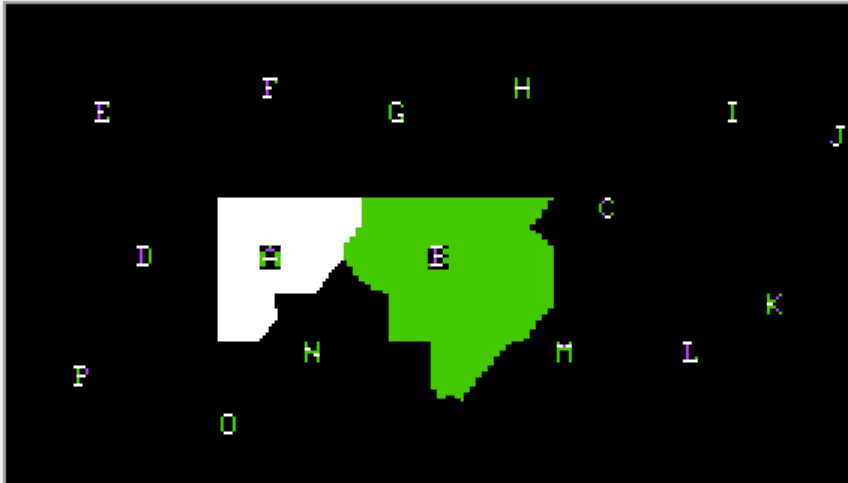
Both sectors are fully developed, with Earth and 3 Commerce Nets in mine (sector A) and 4 Commerce Nets owned by my enemy in sector B :
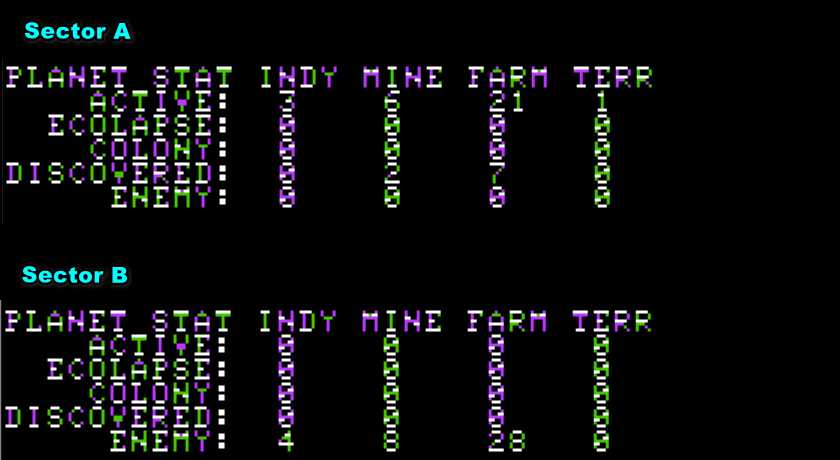
As my new neighbour does not have any Terran planet, I realize I actually have the upper hand :
- Commerce nets have decreasing profitability, so the maximum IOs a player can generate with 4 of them is 7000. With 3 of them and a Terran planet, I can generate 7 750,
- I also need less cargo and so less maintenance cost : my opponent needs 72 cargos to maintain his nets and 100 for max profit, I only need 54 cargos for maintenance and 78 cargos for max profits,
I conclude from this analysis that the best strategy is to attack. If I can cripple the alien commerce nets early on, the rest of the game will be a breeze.
I cannot just right-click my whole fleet into sector B though. To survive, a ship needs :
- to end its turn in a sector in which at least one planet is owned,
- supplies,
Theoretically, I could send several invasion missions and transfer supply from my home sector to the alien sector, but that’s a lot of investment, and a significant risk to lose everything if none of the invasion missions succeeds.
The better solution is to use long-range ships. Long-range ships can move twice in a turn, so they can move to the alien sector, wreak havoc and return. Long-range ships can also carry one friendly ship back & forth – which is good because long-range ships are way less powerful than short-range ships of comparable price.
I don’t start with any long-range combat ships, so I immediately buy 1 raider and 2 lancers :
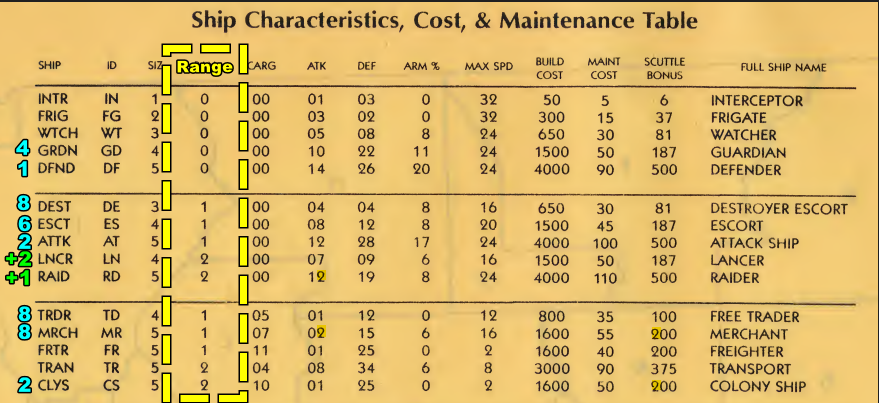
A typical early turn goes like this :
- 3 to 5 long-range ships (1-2 raiders, the rest lancers), each carrying one powerful zero-range ship, jump to the alien sector and run Commerce Raid missions,
- A colony ship also jumps for a dummy “scout” mission (which cannot be intercepted). It is there as security, ready to use its second movement to bring any zero-range ship home if their normal ride is destroyed in combat,
- Two trader/transport/merchant ships run the usual supply missions and immediately repair any planet on the receiving end of a bombardment,
- The rest of the trader/transport/merchant ships run commerce missions to generate IOs,
- Finally, all the short-range ships (destroyers, escorts and attacks) are on patrol,
This repeats, turn after turn.
Mission resolution is dry. The only additional choice you have is whether you want the missions in a sector to be run by small groups or large groups. I use small groups : combats are more dangerous, but I have better odds for at least one group to evade patrols (when attacking) or intercept the enemy (when defending).
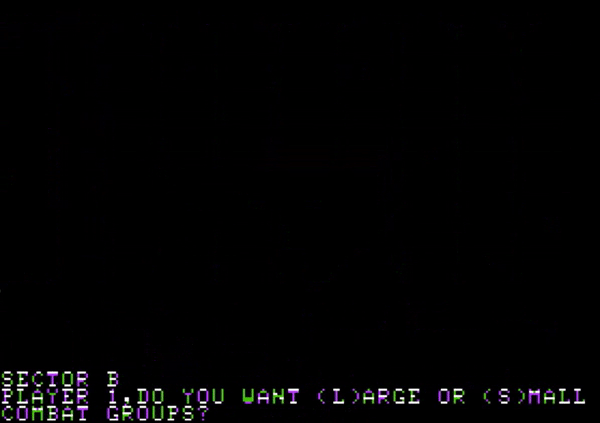
After a few turns, I realize my strategy is a failure. Most of my attacks don’t find any target or are intercepted by enemy patrols, so I destroy between 0 and 2 enemy transport ships every turn and I don’t believe that’s enough.
The good news is that my opponent is also failing hard. It is unlucky with its invasion missions (intercepted by patrols), and its bombardment missions are ineffective : the planets are repaired so fast my commerce nets never stop. I occasionally lose some cargo, including when I lose a colony ship early on, but I am always able to replace them.
So that’s a stalemate – a stalemate that favours me as I outproduce my opponent by 10%. Even better, my ships prevail in more than half the battles, and I destroy more ship value than I lose. This may be because the scenario gives me a better starting tech level. Maybe. The only thing the manual has to say about it is : “The higher your tech level, the more formidable your ship in combat.”
After 5 turns, I decide to change my strategy : let’s directly invade one of their industrial worlds and remove roughly 1/4 of their IOs. I prepare a powerful force and jump into enemy space.
My ships somehow evade the patrols and approach the planet …

Damn ! I lost 8600 IO-equivalent and all I have to show for it is a 300 IO alien frigate removed from the starmap.
After that setback, I stop attacking the aliens and just defend until the end of the game (turn 10). It doesn’t take very long : my opponent is sending at most two attacks by turn now, and occasionally none.
I reach turn 10. I won, even though there is no “the end” message again. I check the final situation of my opponent, and it is not what I expected :
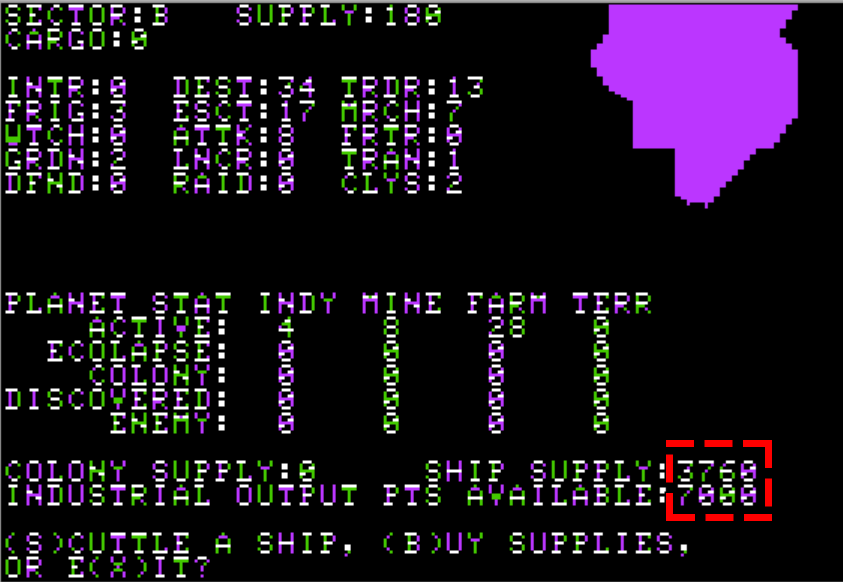
When the game ended, the aliens still had a formidable force, but they were out of long-range attack ships. Their ship maintenance cost was so high they could not afford any of the elite 4000 IOs ships – so they kept sending mediocre ships that never survived interception.
I also compared the starting and end situation of both sides :
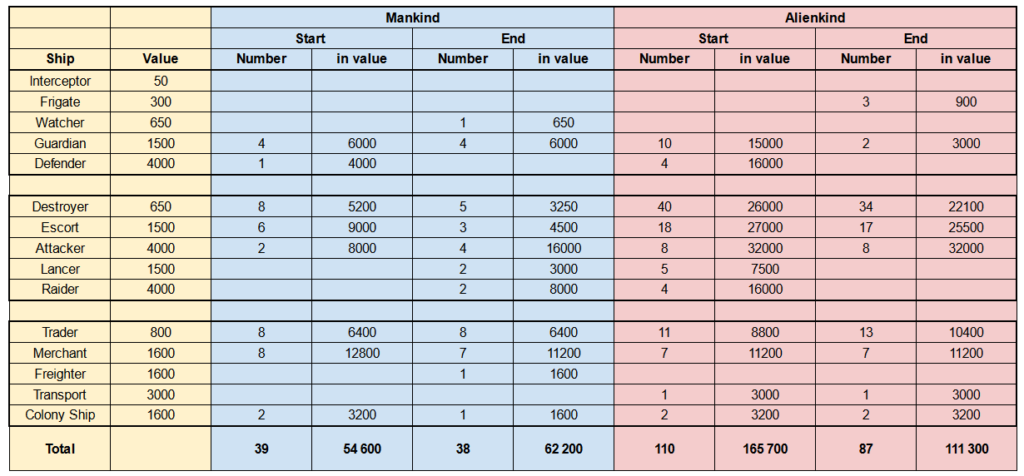
I grew a bit during the scenario, with a total fleet value of 62K (+14%), whereas the aliens lost 33% of their fleet value, mostly because they lost all their long-range ships and the zero-range ships they were transporting in attack. On the other hand, my effort to reduce their cargo capacity during the first half of the scenario had absolutely no effect : their merchant fleet actually increased during the campaign.
With what they start with, I think they could have gone all-in in turn 1 (4 raiders, 4 defenders and the colony & transport ships), focusing on capturing as many worlds as possible. Such an attack early on would have been overwhelming, and with Earth and any other world captured, my revenue would have been halved ! Happily enough, the AI focused on the objectively inferior bombardment missions, and even then I don’t think it ever sent everything it had at the same time. Pretty lucky for mankind, I guess !
That’s all for the introduction to Cosmic Balance II. As for the next steps, I would like your input :
- Cosmic Balance II still has two scenarios : a middle-sized engagement with 7 sectors and a massive campaign. I am not going to do the latter, but do you want to see the official smaller scenario ?
- Alternatively, the game has a “create scenario” feature. I can create a scenario where both sides start with 1 Terran planet, minimum technological level, and from there 4X their ways into victory. This will help to compare Cosmic Balance II with other 4X with similar starts, but I am not sure the AI is designed around such a scenario,
- Finally, maybe you have seen enough of Cosmic Balance II – not that there is much to see in terms of graphics – and would like to move on to the rating & reviews directly.
Please tell me in the comments !
Edit : The first proposition won !